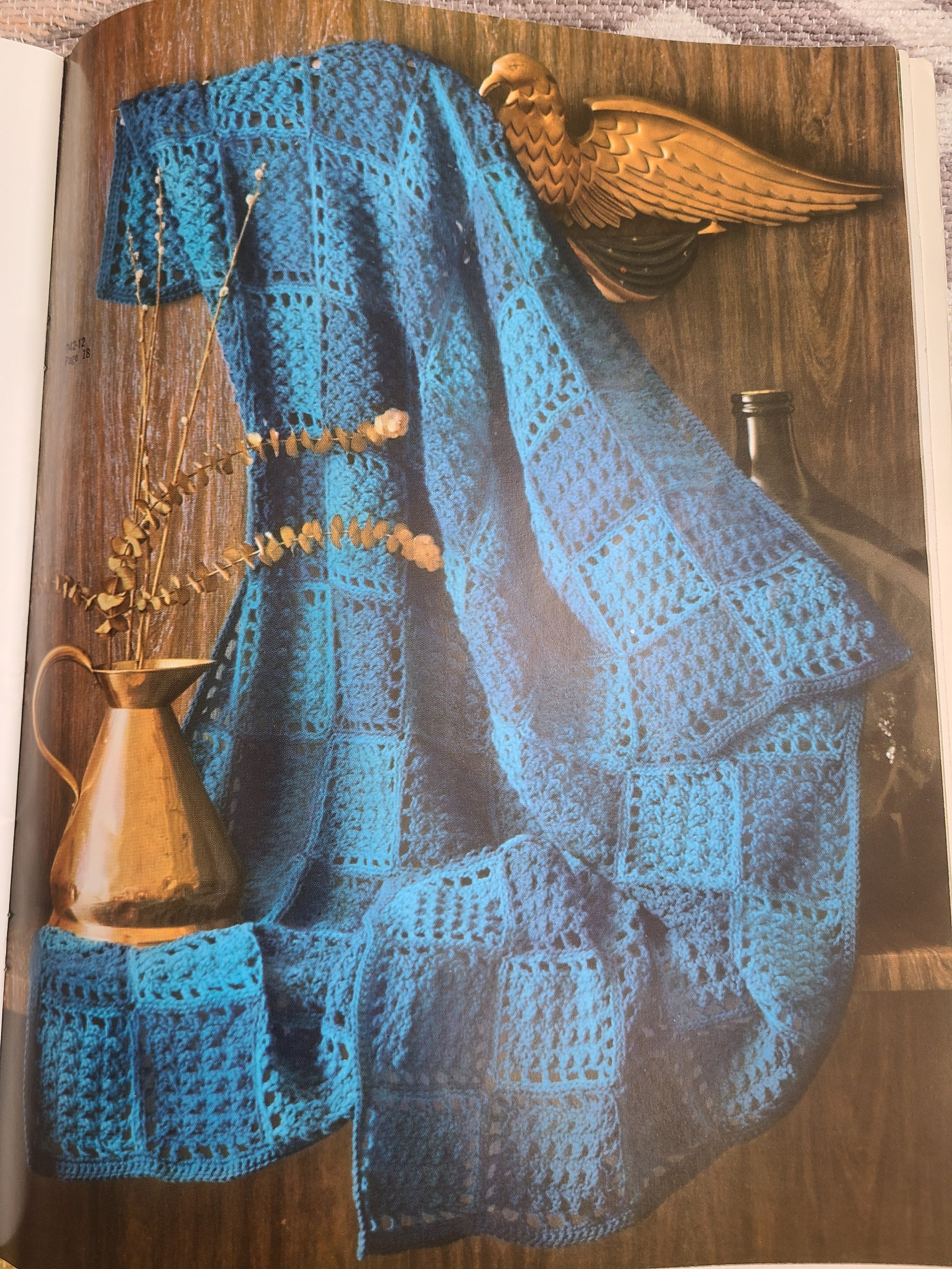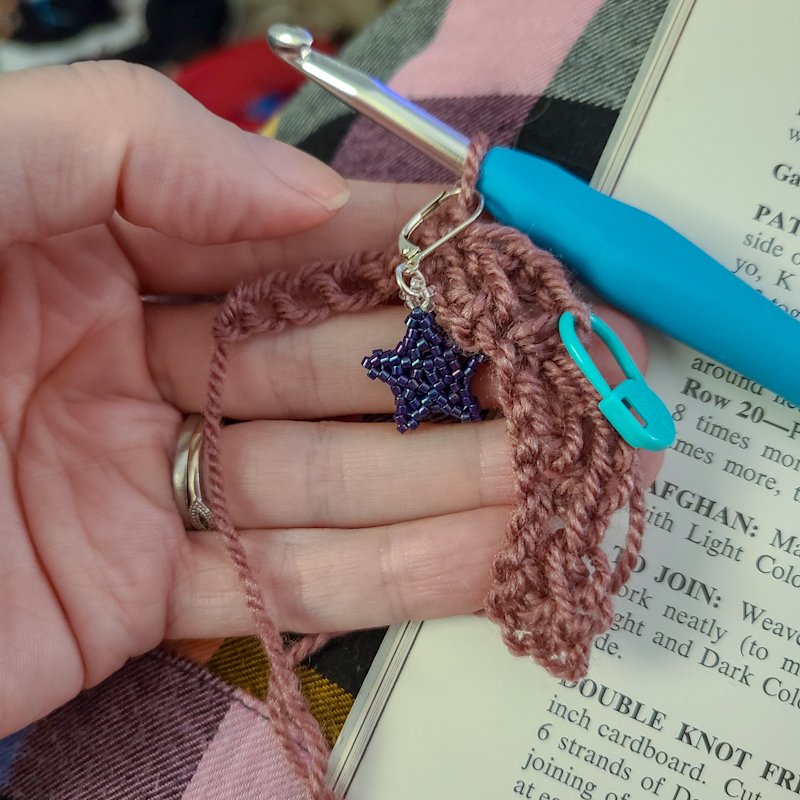The Vintage Afghan Project Episode 3: Crochet Gauge Trials & Tribulations
In this blog series, I chronicle my long-term project of knitting or crocheting every afghan in a vintage Columbia-Minerva Afghans book from 1960. Although the book I am using is out of print, surviving copies are not particularly rare, just search for “Columbia-Minerva Afghans Book 742,” on EBay or Etsy if you’d like to join me on this vintage knitting journey.
As I mentioned last time, since about half of the afghans in the book are crochet, I decided to alternate knit and crochet afghans. Which sounds fine – except I’ve never crocheted anything that wasn’t an amigurumi toy before. I understand how crochet stitches work because of my chart illustration work, I just hadn’t actually tried to make those stitches myself. But after working on the charts for Summer Crochet*, I felt really inspired to expand my crochet horizons and I knew exactly which of the crochet afghans I wanted to start with – the Two-Tone Block Afghan (742-12).
(*This is an affiliate Bookshop.org link. If you happen to purchase the book through that link I do get a small percentage.)
I felt really drawn to the bubbly texture of these squares and figured that since each square was crocheted individually in a single color it would be a fairly simple project to start with (many of the other crochet afghans have multiple colors in one square/hexagon). And it probably would have been … for someone who had been crocheting long enough to have a sense of their own gauge.
This pattern did give a few base measurements to help me figure out if I was meeting gauge; the base chain of 21 for each square should measure about 5 inches in length, and the finished square should be about 4 ½ “ both directions. It took several attempts just to get a 5 inch base chain – I am an extremely tight knitter (I usually have to go up at least one needle size for most patterns), so my first several attempts were far too tight and too short. Then in attempting to chain loosely, I swung too far the other way and was well *over* five inches. I found it useful to keep my sock ruler sitting on my lap while working so I could easily and quickly measure.
Once I was able to get the correct length in the base chain, I then encountered my next problem: learning how to read my own crochet to see where to work each stitch. This was easy enough with the first row, worked into the chain, but on the next row, I was really unsure where the single crochets were that I was supposed to work into. For a couple of squares I marked each single crochet with a removable stitch marker as I finished it, so that I could better see where to work the next row of stitches (I talked about this in my 6 Uses for Stitch Markers post). After a few squares I started to understand better what I was looking at and was able to stop using the markers.
But even working slowly and carefully, my first few squares were pretty wonky, to put it nicely. Some of them were so bad I just unraveled them before I even finished and started over. And the first several that I finished, even with 5” starting chains, were barely 4” square, not anywhere close to 4.5,” no matter how carefully and loosely I tried to work. I started to think I’d just have to resign myself to smaller squares -- and then I did the calculation on how many more squares I’d have to crochet to make a full size blanket and thought I’d at least try a few more times.
And then, suddenly with about 6 squares done (and another half dozen at least worked halfway and unraveled), I started getting consistently and *correctly* sized squares.
The light purple squares on the top were some of my earliest attempts. The dark purple squares on the bottom were made after my gauge became more consistent.
What happened? I believe it’s what’s described in this excellent post by Edie Eckman on the Golden Loop – I was angling my hook towards me as I pulled the yarn through and it was making my stitch height too short. This is why trying to crochet more loosely wasn’t really helping – it might have made my stitch width increase a bit, but I was still compressing my row height. As I felt more comfortable working the stitches, my hook position relaxed and stopped tilting towards me (in Edie’s post she describes the ideal hook position as being basically parallel to your working fabric) and I started getting the correct row height for the pattern.
I won’t lie and say that every square I’ve crocheted since my gauge snapped into place has been perfect – I notice when I go to my craft night I often work a bit wonky, probably because I’m distracted by the conversation. But even the wonky ones are closer to the right size (and will probably be okay with a little blocking and careful seaming).
Above all that, it’s actually been really fun learning a new to me craft for the first time. The rush I got when I started getting more comfortable working double crochet (which I had never done prior to starting this pattern) reminded me of my ballet student days, when I’d finally get the hang of some new step. And learning how to read my crochet the way I read my knitting to diagnose mistakes and figure out how to fix them has been a fun mental challenge.
I’ll check back in when I’ve finished this afghan to talk about the seaming adventure and whether I encountered any other problems as a novice crocheter along the way.
When’s the last time you learned a new craft? What was it, and what bumps did you encounter along the way? If you picked up crocheting as a long time knitter (or vice versa), what was the hardest and easiest part for you to get used to?



